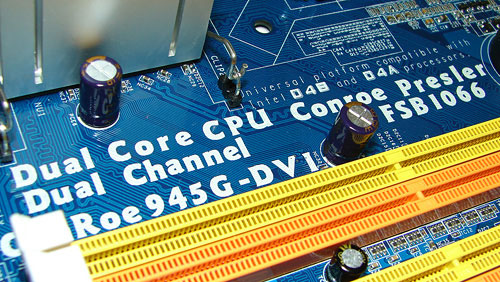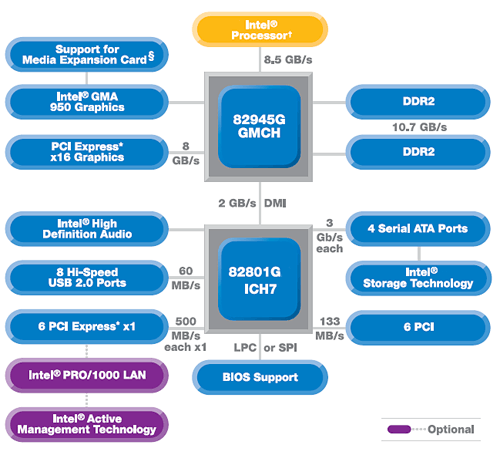ASRock ConRoe945G-DVI: Core 2 Duo goes mATX
by Gary Key on September 1, 2006 5:15 AM EST- Posted in
- Motherboards
"If you would be wealthy, think of saving as well as getting."
This quote by noted author, diplomat, physicist, and politician Benjamin Franklin describes our attitude about the ASRock ConRoe945G-DVI motherboard. While the Core 2 Duo processor series was launched in late July, the availability of motherboards supporting this impressive CPU has not been stellar. We saw a small wave of Intel 975x and P965 chipset boards at launch that are finally starting to mature from a performance and compatibility standpoint. In the meantime we have seen a few additional boards launch based on these same chipsets, along with others using the NVIDIA nForce 570 SLI and NVIDIA nForce4 SLI X16 for Intel series. We have also witnessed some old now new again chipsets come of age based on the performance potential of Core 2 Duo. The VIA PT880Pro, Intel 945P, and Intel 865 fall into the latter category, and now we add our first look at the Intel 945G chipset with Core 2 Duo.

While the 945G has been around for awhile the performance potential of the chipset is still very good, especially for the budget sector, and provides a solid platform for those interested in a mATX form factor board. The 945G will eventually be replaced by the recently released G965 chipset and we expect there to be an almost $40 difference in price between the two platforms for the time being. Whether the G965 is truly worth this premium or not we will see in an upcoming article.
In the meantime, ASRock recently shipped us their ConRoe945G-DVI motherboard for evaluation. The ASRock board is expected to sell for around $75 and brings with it a full set of features including a separate DVI card that allows for dual monitor usage with the onboard Intel GMA950 graphics chip. While the onboard video is fine for general desktop usage and surfing the Internet, it is not meant for 3D gaming no matter how many buzzwords Intel throws out in their GMA950 specification documents. Our article today is meant as brief review of this chipset's capability as implemented by ASRock when compared to a recent review of other budget chipsets. We will have further performance results from this board and others based on the mATX platform in a future roundup.

The 945G chipset used by ASRock in their ConRoe945G-DVI motherboard is over a year old, and it is paired with the Intel ICH7. Our first impression of the motherboard was very good as the layout of the board is clean and well organized for a mATX design. The chart above lists the standard feature set available when utilizing the Intel 945G (82945G) and ICH7 (82801GB) chipsets. The 945G/ICH7 combination enables full support for a single X16 PCI-E graphics slot or onboard GMA950 graphics configuration, a single HDMR slot, up to six X1 PCI-E devices, 4GB memory addressability, and native DDR2 533/667MHz memory support. This combination also enables support for eight USB 2.0 ports, HD Audio, Gigabit Ethernet support, six PCI slots, four SATA 3.0Gb/s ports, and two IDE devices. The 945G chipset does not support the Pentium EE or XE series of processors.
Now let's take a closer look at the performance this board offers.










33 Comments
View All Comments
JarredWalton - Friday, September 1, 2006 - link
The SATA issues at least are chipset/BIOS/motherboard dependent. As this uses an Intel 945G chipset, it should work fine with SATA. NVIDIA chipsets should also work fine, but I don't know what exactly ASRock did with the AM2NF4G-SATA2. Normally, for XP installs you want to set the SATA ports to IDE mode, and once XP is installed with all the drivers you can switch to AHCI mode instead... not that there's much performance difference anyway.In terms of stability, have you run without the OC? I really don't trust $50-$60 boards for overclocking. Some will do it, but it's still a bit of an iffy propositions for long-term use. I'd much rather spend $100 on a board I know will OC reliably.
yyrkoon - Friday, September 1, 2006 - link
Yeah, I ran everything per spec. for 3 weeks, and wasnt until recently that I decided to OC it. My thinking is that, if this board isnt going to be stable for more than 3 days, I dont care much for it anyhow. Also, I had planned on replacing it with a ABIT AN9 32x when I bought it. Now Im starting to think maybe I'll replace it with a ABIT AB9 Pro, and a E6x00 CPU.Anyhow, the HTT is slightly above 1000MHZ, the memory is running ar 832MHZ, and CPU is reported by the BIOS as running at 2.76GHZ (although CPU-Z says a bit lower), and its running as stable, load, or idle as before. CPU temperatures havent exceeded 122F much, if at all. I have run nvmonitor stability tests, and sandra burn-in test on this system without a hitch, and if you think about it, 16% really isnt a huge OC . . .
JarredWalton - Friday, September 1, 2006 - link
I'm guessing you have a 4200+ chip, right? 11X multiplier with a 250 MHz bus?Deoending on CPU, RAM, etc. you're possibly hitting other limits. Just for kicks, try dropping the RAM from DDR2-800 to a lower speed, like set it for DDR2-533 instead of DDR2-667. That should put the RAM at DDR2-611 vs. DDR2-786 (with a 250 MHz HTT speed).
I would also adjust the memory timings for more conservative values. I'm guessing that with limited memory voltages, you might have problems running any DDR2 memory at 800 MHz. It's a thought anyway. :)
yyrkoon - Friday, September 1, 2006 - link
Also, according to Sandra, my memory bandwidth is slightly above 7000MB/s int, and float. IS this decent ?yyrkoon - Friday, September 1, 2006 - link
Oh, sorry here:Asrock AM2NF4G-SATA2
AMD 64 3800+ (single core)
2x1 GB Cosair XMS 6400 DDR2
eVGA 7600GT KO (stock), Antec SL 450 450W PSU.
Since on this board there is no divider settings (or atleast none that I know of), basicly, all I've adjusted is memory (533,667,800), HTT link speed, CPU FSB, and multiplier. First I started off at 12x multiplier, and achieved a 230 FSB, anything above, wenbt unstable either in windows, or wouldnt boot. Here, I noticed the memory was quite capable of 880MHZ DDR, but I've had it as high as 902MHZ DDR stable(5-5-5-18). This memory will also run 4-4-4-12 stock volts at stock settings(even though SPD says otherwise). OK, then I dropped the multiplier, and increased FSB in increments of 10's until it failed to boot, then I dropped HTT link speed(800/1600), and memory to 533 standard. After this I increased FSB speed by 10's again, until falure, and eventually arrived at 250MHZ. Dropping the multiplier to 10x would not post with minimum FSB speed I wanted, so I called it quits.
So in summer basicly, right now, my HTT link is 800/1600, multiplier 11x, and memory is set to DDR2 667 (in the BIOS). nvmonitor reports CPU is running at 2.7x, memory is running at 832, and HT bounces around from high 900's to low 1000's. CPU-Z says the memory speed is 392.xx, CPU is 2.7x, and HT is 1000.
As far as I know, I've done about all I can, and still maintain a decent clock/ ratio settings. However, I havent OC's since I owned a P55 233mmx CPU (yes, MANY years ago) so I may be missing something. If so, Im all ears :)
yyrkoon - Friday, September 1, 2006 - link
err summer = summary ? :/JarredWalton - Saturday, September 2, 2006 - link
Your CPU multiplier should only affect things if you set it lower than stock. The Athlon 64 3800+ has a 12X multiplier by default. I generally don't think there's much point in using lower multipliers, as the difference in memory bandwidth has very little impact on Athlon 64 processors. At the stock 12X multiplier, you get nicer memory ratios at DDR2-800 and DDR2-533 settings. Remember that memory speed is actually based off of a divider of the CPU speed. So:12 x 200 = 2400 MHz
DDR2-800 = CPU/6 = 400 MHz (DDR2-800)
DDR2-667 = CPU/8 = 300 MHz (DDR2-600)
DDR2-533 = CPU/9 = 267 MHz (DDR2-533)
Overclocked:
12 x 233 = 2796 MHz
DDR2-800 = CPU/6 = 466 MHz (DDR2-932)
DDR2-667 = CPU/8 = 350 MHz (DDR2-799)
DDR2-533 = CPU/9 = 311 MHz (DDR2-621)
Change the multiplier to 11X and you get the following:
11 x 200 = 2200 MHz
DDR2-800 = CPU/6 = 367 MHz (DDR2-733)
DDR2-667 = CPU/7 = 314 MHz (DDR2-629)
DDR2-533 = CPU/9 = 244 MHz (DDR2-489)
Notice how certain memory ratios and up with odd final results. That's what you're getting right now most likely. Let's say you go with a 250 MHz bus as an overclock. This is what you get:
Overclocked:
11 x 250 = 2750 MHz
DDR2-800 = CPU/6 = 458 MHz (DDR2-917)
DDR2-667 = CPU/7 = 393 MHz (DDR2-786)
DDR2-533 = CPU/9 = 306 MHz (DDR2-611)
yyrkoon - Saturday, September 2, 2006 - link
Jarred, heres a link to a post I made on the forums, if you care to comment further, to see a couple of OC test cases I've done so farhttp://forums.anandtech.com/messageview.aspx?catid...">http://forums.anandtech.com/messageview...amp;thre...
yyrkoon - Saturday, September 2, 2006 - link
Perhaps I should benchmark both, although all sanda CPU tests already indicate that my system performs a slight bit slower than a Fx-57 system.The reason why I dropped the multiplier, was in hopes of gaining a higher CPU Frequency, which proved true. My thinking was that if voltage is limiting my increases, perhaps lower the multiplier will relax the CPU some. Since memory bandwidth to a point is rather moot, memory bandwidth isnt a big deal IMO either, how I may do some serious benchmarking comparrison for the hell of it, and may even post them somewhere. I can tell you however that Oblivion does perform better with the OC (was the first thing I checked).
Dfere - Friday, September 1, 2006 - link
Anyone give me a general ballpark on what this integrated video should perform as? 6200 TC ?? 7300?Thanks